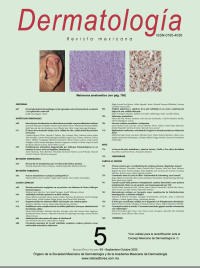Dermatol Rev Mex. 2025; 69 (5): 671-675. https://doi.org/10.24245/dermatolrevmex.v69i5.10739
Verónica Martínez García, María Alejandra Monroy Jiménez
Médico residente de Medicina Interna, Hospital Regional Gral. Ignacio Zaragoza, Instituto de Seguridad y Servicios Sociales de los Trabajadores del Estado, Ciudad de México.
Resumen
ANTECEDENTES: El síndrome DRESS es una reacción cutánea farmacológica adversa, asociada frecuentemente con fármacos: fenitoína, fenobarbital, carbamazepina, sulfonamidas, entre otros. El daño sistémico es más frecuentemente hepático y puede ocasionar desde elevación de enzimas hepáticas hasta hepatitis fulminante. Puede diagnosticarse de forma clínica, con apoyo de los criterios del regiSCAR y requiere vigilancia de las posibles complicaciones hepáticas, renales, cardiacas y pulmonares. El tratamiento es de soporte y sintomático; debe suspenderse el fármaco causal e incluye, principalmente, esteroides y antihistamínicos.
CASO CLÍNICO: Paciente femenina de 20 años, que acudió a consulta con exantema morbiliforme generalizado, con tendencia a confluir, que formaba placas en el abdomen y la región púbica, acompañado de prurito intenso y fiebre, luego de 13 días de iniciar tratamiento con carbamazepina. Durante su hospitalización se evidenció elevación brusca de enzimas hepáticas, que remitió tres días posteriores al pico. La paciente cursó con adecuada respuesta al tratamiento con esteroides.
CONCLUSIONES: Las reacciones cutáneas adversas representan del 0.1 al 5% de los efectos adversos a fármacos y pueden ser fatales, incluso, en 5-10%. Debe considerarse el daño visceral tomando pruebas como: función hepática y renal, de coagulación, radiografía o tomografía de tórax, electrocardiograma, perfil tiroideo y marcadores de inflamación como PCR y VSG. El daño hepático se manifiesta con más frecuencia en patrón colestásico y ciertos parámetros, como la linfocitosis atípica y el tipo de fármaco relacionado, pueden ayudar a predecirla.
PALABRAS CLAVE: Síndrome DRESS; exantema; carbamazepina, dermatitis.
Abstract
BACKGROUND: DRESS syndrome is a drug adverse skin reaction, often associated with drugs such as phenytoin, phenobarbital and carbamazepine, sulfonamides, and more. Systemic involvement is more frequently hepatic and can cause elevation of liver enzymes to fulminant hepatitis. It can be diagnosed clinically, supported by the criteria of regiSCAR and requires surveillance of possible liver, renal, cardiac and pulmonary complications, among others. Management is supportive and symptomatic, discontinuing the causal drug and may include steroids and antihistamines primarily.
CLINICAL CASE: A 20-year-old female patient, who attended with generalized morbiliform rash, with a tendency to converge forming plaques in abdomen and pubic region, accompanied by intense itching and fever, after 13 days of starting treatment with carbamazepine. During her hospital stay, there was evidence of abrupt elevation of liver enzymes, which remitted three days after the peak. The patient had an adequate response to steroid treatment.
CONCLUSIONS: Adverse skin reactions account for 0.1% to 5% of adverse drug effects and can be fatal up to 5-10%. Visceral involvement should be considered by taking tests such as liver and kidney function, coagulation, chest X-ray and/or tomography, electrocardiogram, thyroid profile, and markers of inflammation such as PCR and VSG. Hepatic involvement occurs more frequently in a cholestatic pattern and parameters such as atypical lymphocytosis and the type of drug involved can help predict it.
KEYWORDS: DRESS syndrome; Exanthema; Carbamazepine; Dermatitis.
ORCID
https://orcid.org/0000-0002-6300-4928
https://orcid.org/0000-0002-1043-4334
Recibido: julio 2023
Aceptado: diciembre 2023
Este artículo debe citarse como: Martínez-García V, Monroy-Jiménez MA. Hepatotoxicidad en síndrome DRESS relacionado con carbamazepina. Dermatol Rev Mex 2025; 69 (5): 671-675.

